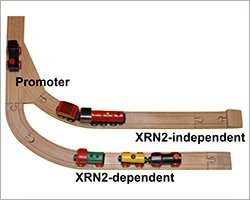Gene promoters determine how the transcription machinery is stopped at the end of the gene. Credit: Friedrich Miescher Institute for Biomedical Research
Helge Grosshans and his group at the Friedrich Miescher Institute for Biomedical Research (FMI) have identified two distinct modes of transcription termination – one dependent on, and one independent of, the highly conserved exoribonuclease XRN2. In a fruitful collaboration between wet-lab and computational biologists, they found that the promoter of a gene determines the mechanism for termination of its transcription.
When genetic information is transcribed from DNA to RNA, it is important not only where the process starts but also where it stops. Failure of termination causes "readthrough" into adjacent genes, disrupting their regulation or generating wasteful and possibly harmful fusion transcripts. But, as FMI Group Leader Helge Grosshans points out, "Transcription termination has been largely a black box; apart from an emerging consensus on the importance of a protein known as exoribonuclease 2 (XRN2), little was known about relevant factors and mechanisms."
Grosshans and his group have now looked in more detail at transcription termination in the roundworm Caenorhabditis elegans. Their findings have been published in the journal Genes & Development.
In their study, the scientists examined the effects of inactivating XRN2. They found that transcription failed to be terminated at the ends of many genes – as expected. Unexpectedly, however, for many other genes, termination occurred normally. Grosshans comments: "Our results show that some genes require XRN2 for termination, whereas others do not. In fact, transcription of the latter appears to be refractory to termination by XRN2 activity."
Further analysis of the two classes of genes revealed that the mode of termination was specified by gene promoters. Grosshans explains: "This was a big surprise. Promoters are adjacent to the transcriptional start site, determining when and where transcription begins, whereas termination occurs at the far end of a gene. We would have expected to find factors determining the mode of termination near the site of termination itself; instead, the ability of XRN2 to terminate transcription was already specified by the promoter."
Based on this observation and the fact that XRN2 binds to both classes of genes – those that require it for termination and those that do not – the scientists propose two modes of action for transcription termination. In the first mode, the interaction of XRN2 with the transcription machinery at the end of a gene dissociates this machinery from the DNA, releasing the transcript. In the second, the transcription machinery may differ in composition or configuration, preventing XRN2 from disrupting its interaction with DNA. Termination is then the result of other molecular processes.
Grosshans concludes: "Our findings are a first step towards a better understanding of transcription termination. A major question to be answered now is what factors drive XRN2-independent termination."
More information: Takashi S. Miki et al. Two distinct transcription termination modes dictated by promoters, Genes & Development (2017). DOI: 10.1101/gad.301093.117
Journal information: Genes & Development




















